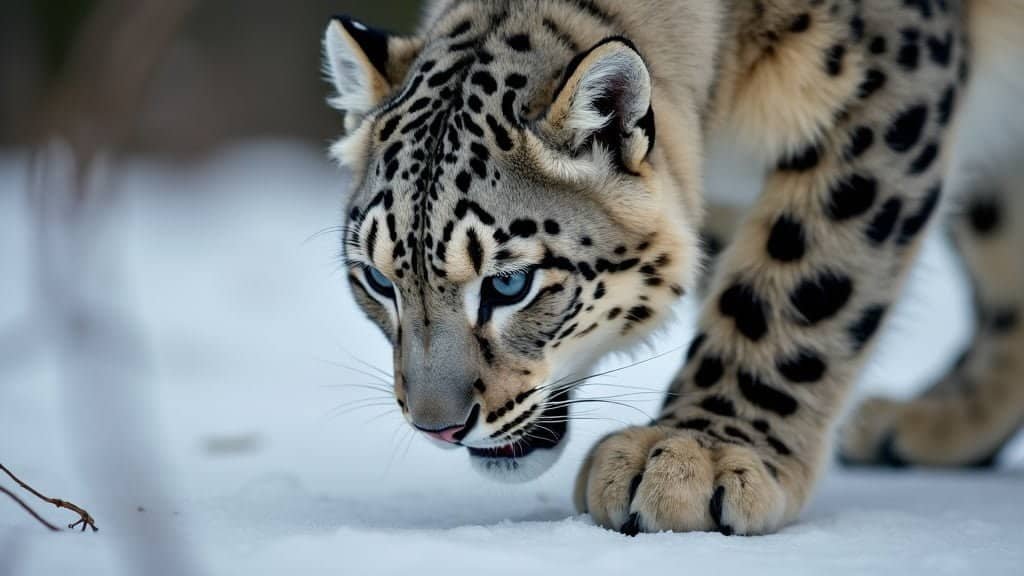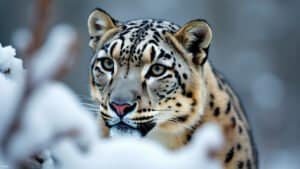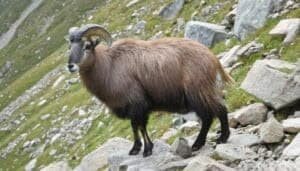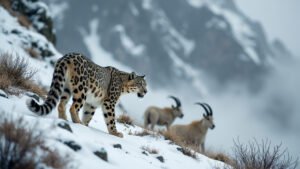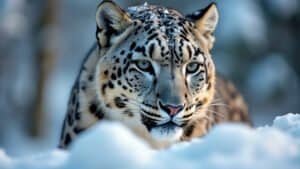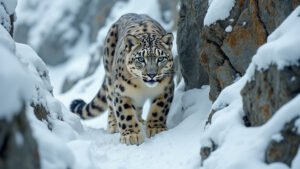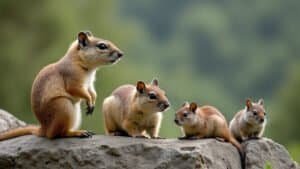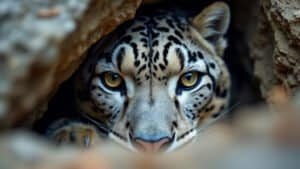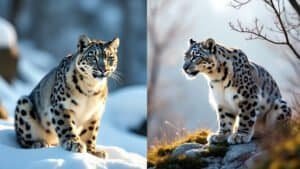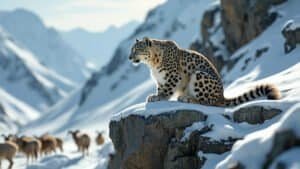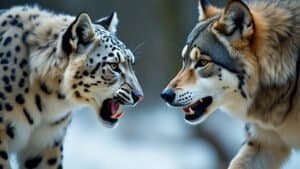Introduction
Snow leopards, elusive predators of the high mountains, have adapted to some of the world’s harshest environments. Among their many survival tools, their sense of smell plays a crucial role in their hunting strategies
This article delves into the significance of smell in snow leopard hunting, exploring how these big cats detect and track prey, compare with other felines, and use scent to communicate and establish territory
By understanding these mechanisms, we gain deeper insights into the survival tactics of these magnificent creatures
The Importance of Smell in Snow Leopard Hunting
Snow leopards are highly skilled hunters, relying on a variety of senses to locate and capture prey in the rugged terrain they inhabit. Among these senses, their sense of smell is particularly vital
This olfactory capability allows them to detect prey, communicate with other leopards, and establish territory. Understanding the importance of smell in snow leopard hunting sheds light on how these solitary predators thrive in such a challenging environment
Understanding the Role of Smell in Predator Behavior
In the animal kingdom, the sense of smell is one of the most critical tools for survival, especially for predators. For snow leopards, this sense is not just about detecting food; it’s a multi-faceted tool that aids in navigation, territory marking, and social interactions
The olfactory system of a snow leopard is highly developed, enabling it to pick up even the faintest of scents in its environment. This sensitivity is particularly crucial in the mountainous regions where these leopards live, as prey is often spread out over vast distances and hidden in dense terrain
Research has shown that snow leopards can detect the scent of prey animals, such as blue sheep or ibex, from miles away, allowing them to track their movements even when visibility is low due to fog or snow
Comparing Snow Leopard and Other Big Cats’ Sense of Smell
When comparing the olfactory abilities of snow leopards with other big cats, some fascinating differences emerge. While all big cats, including lions, tigers, and leopards, possess an acute sense of smell, snow leopards have adapted to their specific environment in unique ways
For instance, the nasal structure of a snow leopard is specialized to warm and humidify the cold, dry air of their high-altitude habitats before it reaches their lungs. This adaptation also aids in enhancing scent detection in thin, cold air where scent particles disperse more quickly
Unlike lions, which often rely on sight and sound due to their open savanna habitats, snow leopards depend heavily on smell to locate prey that might be hiding in rocky crevices or dense underbrush
Their sense of smell is so finely tuned that they can detect not only the presence of prey but also differentiate between the scents of different animals, which helps in prioritizing potential targets based on size, health, and vulnerability
Specific Scents Snow Leopards Rely on During Hunts
Snow leopards rely on a variety of scents to successfully hunt and navigate their environment. Prey animals emit various smells that can indicate their presence, health, and even recent activities
For instance, the scent of urine, feces, and sweat glands can provide the snow leopard with detailed information about the prey. The snow leopard’s ability to discern these subtle differences in scent helps it determine the most opportune moment to strike, minimizing the effort and energy expended during the hunt
Furthermore, snow leopards can detect the scent of injured animals, which may present easier targets, especially in a landscape where energy conservation is crucial for survival
In addition to tracking prey, snow leopards also use scent to avoid potential dangers or rival predators, ensuring they do not encounter other large carnivores that might pose a threat or compete for the same prey
How Snow Leopards Use Their Sense of Smell to Track Prey
Snow leopards live in some of the most inhospitable environments on Earth, where food is scarce, and the landscape is rugged. Their ability to track prey using their sense of smell is a key factor in their survival
This section explores the various ways in which snow leopards employ their keen olfactory senses to locate and hunt down prey in their mountainous habitats
Detecting Prey from a Distance Using Smell
One of the most remarkable aspects of a snow leopard’s sense of smell is its ability to detect prey from significant distances. In the high-altitude regions of Central and South Asia, where these cats are found, visual cues can be limited due to the dense fog, heavy snowfall, and rocky terrains that often obscure sightlines
The snow leopard’s olfactory abilities compensate for this by allowing it to pick up the scent of prey animals, such as bharal (blue sheep) or ibex, from several miles away. Studies have shown that snow leopards can follow a scent trail for long distances, sometimes tracking their prey over several days before making a move
This ability to detect and track prey from afar ensures that the snow leopard can plan its approach carefully, conserving energy in an environment where every hunt counts
Tracking Injured or Hidden Prey by Scent
Injured or hidden prey offers a unique opportunity for snow leopards, as these animals are often more vulnerable and easier to catch
The snow leopard’s acute sense of smell allows it to detect the scent of blood or other bodily fluids from injured animals, even when these animals are hidden from view. For example, an ibex that has recently been wounded may leave a stronger scent trail that the snow leopard can follow with precision
In rocky terrains or dense forests, where visual confirmation of prey might be impossible, this olfactory skill becomes indispensable. Snow leopards are known to use their sense of smell to locate animals that have taken refuge in caves, under snow, or in thick vegetation
By following these scent trails, snow leopards can surprise their prey, striking at the most opportune moment when the animal is least capable of fleeing
Environmental Factors Influencing Smell Detection
The ability of snow leopards to detect prey by scent is not without its challenges. Various environmental factors can influence how well these cats can track prey using their sense of smell. Wind direction, for example, plays a crucial role in carrying scent particles across distances
Snow leopards are known to move strategically in response to wind patterns, positioning themselves downwind of their prey to ensure that the scent is carried directly to them. Temperature and humidity levels also affect scent detection; colder temperatures tend to preserve scent trails longer, while warmer temperatures may cause them to dissipate more quickly
Snow and rain can further complicate scent tracking, as they can either enhance the scent by releasing more particles into the air or wash it away entirely
Despite these challenges, snow leopards have evolved to read these environmental cues effectively, adjusting their hunting strategies accordingly to maximize their chances of success
Communication and Hunting: The Dual Role of Scent
Snow leopards use their sense of smell not only for hunting but also as a vital tool for communication. In the harsh and isolated environments where they live, scent plays a crucial role in marking territory, signaling reproductive status, and even influencing hunting strategies
This section delves into how snow leopards use scent to communicate with others and how these olfactory signals intersect with their hunting behaviors
Scent Marking and Territory Establishment
Scent marking is a fundamental behavior for snow leopards, serving as a means of establishing and maintaining territory. In the vast and often sparse habitats they occupy, snow leopards rely heavily on scent to communicate their presence to other leopards
By marking trees, rocks, and other prominent features in their environment with urine, feces, or glandular secretions, snow leopards send clear signals about their territory boundaries. These scent marks convey critical information, such as the individual’s identity, sex, reproductive status, and even health condition
This form of communication helps snow leopards avoid unnecessary confrontations with rivals, as the scent marks act as a warning to other leopards to stay away
The regular renewal of these scent marks is crucial, especially in areas where scent trails may be diminished by harsh weather conditions like heavy snowfall or rain
How Scent Marking Affects Hunting Strategies
Scent marking has a direct influence on a snow leopard’s hunting strategy. By establishing clear territorial boundaries, snow leopards reduce the likelihood of encountering other predators that might compete for the same prey
This territorial behavior allows them to hunt within a defined area where they are familiar with the terrain, prey habits, and environmental conditions. Moreover, scent marking can also serve to attract mates, particularly during the breeding season. During this time, a snow leopard might alter its hunting behavior to ensure it has enough energy reserves for both mating activities and successful hunts
Additionally, by marking their territory, snow leopards can signal to potential competitors that the area is occupied, thus reducing the chances of another predator disturbing a hunt or claiming a kill
Interaction with Other Snow Leopards Through Scent
Scent is not only used to repel rivals but also to facilitate interactions between snow leopards, particularly during the mating season. Female snow leopards, when in estrus, will leave specific scent marks that communicate their readiness to mate
These olfactory cues are crucial for males, who may travel long distances following these scent trails to find a receptive female. The exchange of scent between male and female snow leopards can also influence hunting dynamics, as the presence of a potential mate can temporarily alter a leopard’s priorities
In some cases, males and females may even hunt together or share kills during this period, a rare occurrence given the typically solitary nature of these animals
Understanding these interactions provides insight into the complex social behaviors of snow leopards, where scent serves as a bridge between their solitary lifestyle and the occasional need for contact with others
Conclusion
Snow leopards rely heavily on their keen sense of smell to survive and thrive in the harsh environments of their mountainous habitats
From detecting prey at great distances to communicating with other leopards through scent marking, their olfactory abilities play a crucial role in both hunting and social behavior
By understanding these sophisticated strategies, we gain deeper insight into the snow leopard’s life, revealing how they have adapted to some of the world’s most challenging terrains. Whether tracking hidden prey, marking territory, or signaling readiness for mating, the snow leopard’s sense of smell is an indispensable tool in its survival toolkit
